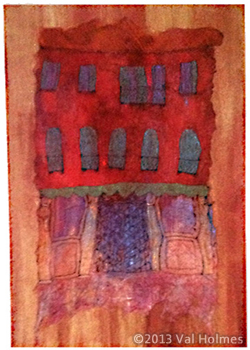by Jacqueline Gikow

Recycling objects and images has been a part of the avant-garde art practice since Marcel Duchamp’s found objects of the early 20th century. In the 21st century it is now part of a major wave in contemporary art. The inclusion of significant objects in a piece of artwork can be used to add meaning. These objects may be of a personal nature and give your work a feeling of personal history or the memory of a particular person or memory.
Recycling in art is often an expression of our over-consumer society, where everything is short lived and throwaway. For recycling to work as a part of a textile process, the objects recycled should be chosen for the textures and surfaces that can be created through their use.
Wool fiber has tin overlapping scales, which allow them to be felted together to create a firm fabric through the use of moisture, friction and, possibly, heat. Then the fibers are rubbed together in a wet environment, these scales lock together.
The more they are rubbed, the more they will lock and the stronger the felt will be. Throughout history this process has been employed differently in many parts of the world to convert wool into a strong fabric. Creating wool felt is a relatively easy, but time-consuming process. For the beginner, the easiest fibers to use are wool tops.
Materials and Supplies
Old towels - folded onto a table
Bubble wrap
Wool tops - merino wool is a good choice for the beginner
Any bits and pieces of thread or fabric for embellishment
Warm soapy water (made from real soap flakes)
A pole, dowel or bamboo mat
2 pieces of net or old net curtain
Technique
Place one layer of bubble wrap onto the towels and then put a layer of net on top.
Pull the wool fiber and spread them out, laying them in one direction, then place another layer of fibers at right angles to the first layer. A third layer can be employed as well in the same direction as the first layer. You can also incorporate other bits and pieces and fibers into this last layer.
Place the second layer of net on top and rub the warm or hot soapy water into the work until it is completely wet. Place the dowel at one end of the work and roll it up.
The next step is to create friction by rolling and unrolling your work. One way of doing this is to hold the fiber over a bowl vertically and roll the dowel between your hands, making sure that the roll doesn’t come undone. Do this several hundred times. Alternatively, roll the felt backwards and forward, rolled up in a bamboo mat. Count 100 times at least.
There are no secrets to felt making. Mainly the process of causing the fibers to felt is physical and takes time.
This process can produce a very fine “wool paper” or “felt” that is much finer than is usually possible with the normal felting process. The result can be stitched into, although placing it on a firmer backing is recommended. (Dissolvable fabric is available at a fabric store).
Place the plastic sheet on your working surface and lay one piece of net on top. Pull out your merino wool fibers as long as possible and place them, overlapping on top.
Cut fibers of different colors, bits of thread or fabric, petals and leaves or silk tops can all be incorporated at this stage. Place a fine layer of any incorporated bits. Then lay a second layer of net on top of the fibers.
Work cellulose wallpaper paste into the fibers through the net.
Turn over the work carefully with the fiber sandwiched between the two pieces of net an place them the other way on the plastic surface. Now work the paste into this side until there are no more dry patches.
Hang the paper up to dry thoroughly.
Once it is dry, pull the net gently away from the fiber surface.